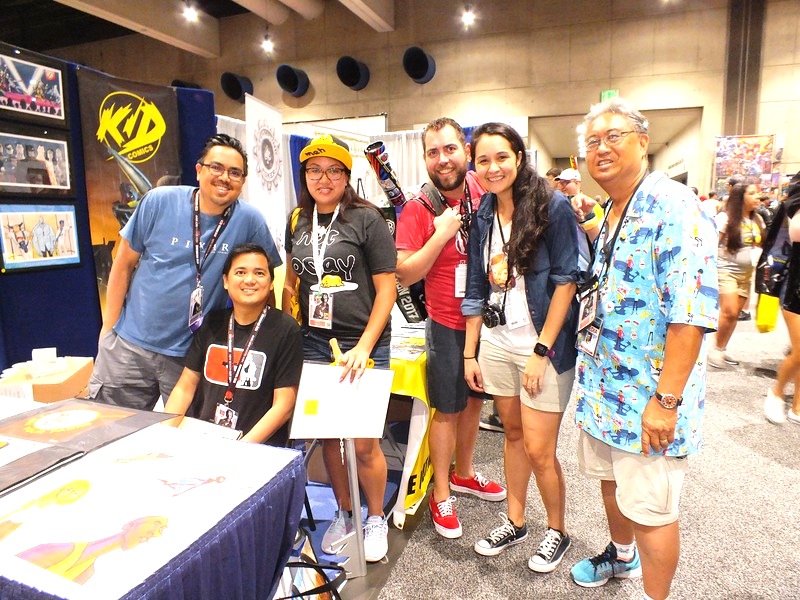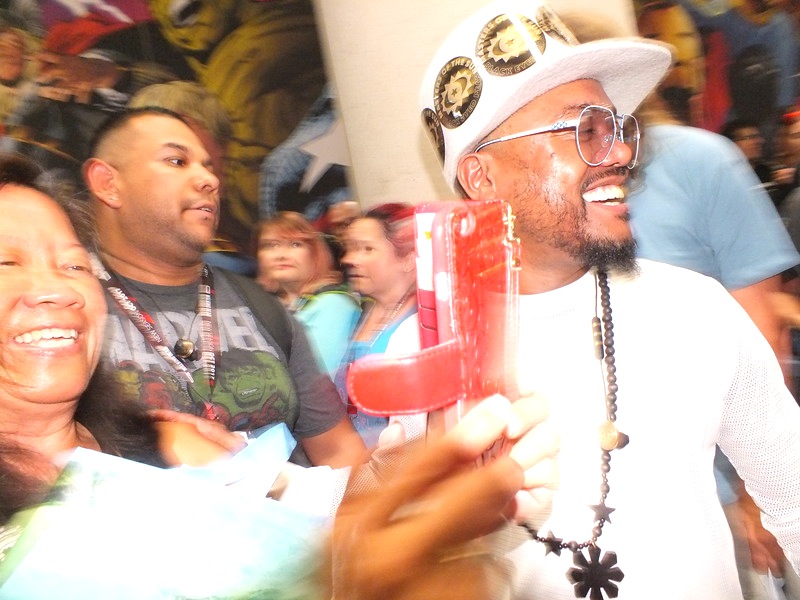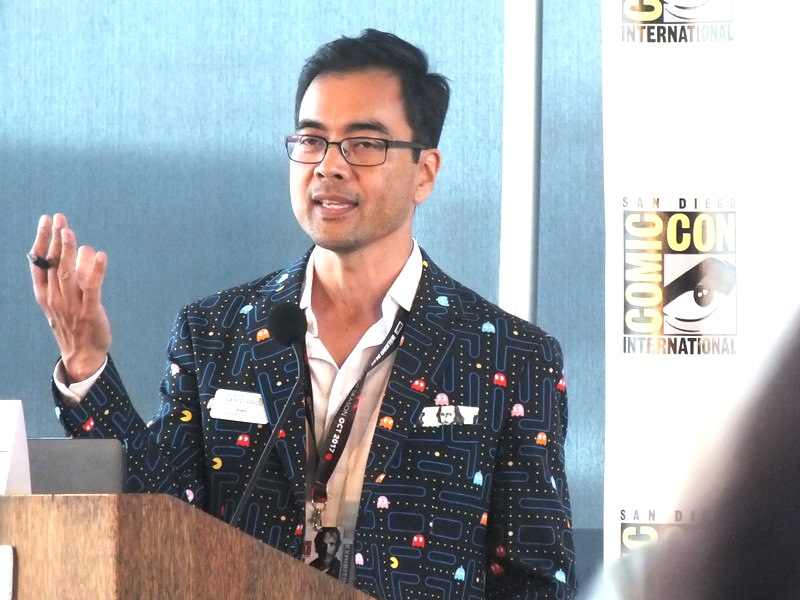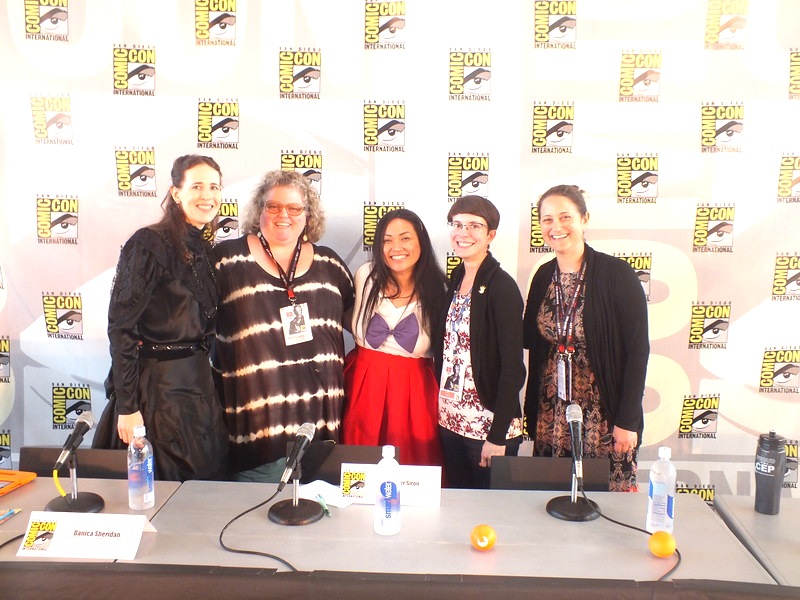At Comic Con, Fil-Am librarians plug comics as teaching tools

Pixar animator and creator of the popular Alcatraz High comic books, Bobby Rubio, (left) is joined by his Warner Bros. Animation Director-brother Ronald Rubio (seated) along with fans from the Asian/Pacific American Librarians Association (APALA) at his SDCC booth. INQUIRER/Florante Ibanez
SAN DIEGO, California – While Filipinos have long appreciated animation and comic books beyond these media’s entertainment value, for the second time educators and librarians held their own specialty conference at San Diego Comic Con to discuss comic books’ pedagogical importance.
San Diego International Comic Con organizers asked Erwin Magbanua, programming and special events coordinator-librarian at the San Diego Central Public Library to organize and host a specialty programming for educators.
The free public event had hundreds of educators and librarians flocking to the San Diego Central Library during the hectic Comic Con week, which is held every July at the San Diego Convention Center and surrounding hotels and other venues.
Members of the Asian/Pacific American Librarians Association (APALA) made presentations. One panel moderated by Candice Mack, APALA member and past president of the American Library Association (ALA) Young Adults Library Services Association (YASA), explained how popular culture media such as comic books and graphic novels provide learning through “visual literacy.” Children start looking at books that have pictures, help them learn to read.

Rose Ibanez catches a selfie with APL of the Black Eyed Peas during the promotion of their new Marvel venture “Masters of the Sun” at the recent San Diego Comic Con. INQUIRER/Florante Ibanez
Filipina Youth Services Librarian Myleen De Jesus from the Santa Monica Public Library said, “We have had some comic book related programs that were very well received. We have partnered with some local comic bookstores. In collaboration with local schools we have a few titles as required readings in grades 6, 7, & 8 as part of the English curriculum.”
De Jesus said her library has used titles like Maus (a graphic novel about the WWII Nazi death camps) and Smile (a NY Times #1 bestseller graphic novel about a 6th grader).
“We are looking forward to adding more titles because they are historically accurate and viable texts. There are still stories that have to be told regarding diversity. It’s not quite there yet. I’m hoping that in the next five years there will be more stories about intercultural, mixed race kids, teens and even adoption stories,” De Jesus said further.
Conference organizer Erwin Magbanua was delighted to have his San Diego Library host the free public event. “Comic books being visual media, there’s a lot of potential there to tell stories and diverse stories of people’s from around the world well beyond the written word. It just hits you,” he said.
“Growing up I didn’t see myself in any of forms of media, TV or movies in America so I didn’t feel that I was part of society, until I went to college and someone introduced me to Lynda Berry, who is part Filipino, and this came to me as a big surprise. Her comics included Filipino characters; it just floored me, it changed me as a young man coming up in the world and not really being in touch my culture, not really seeing myself,” Magbanua recalled.

Erwin Magbanua hosts the 2nd Annual “Comic Conference for Educators and Librarians” as part of the 2017 San Diego International Comic Con (SDCC) at the San Diego Central Public Library, held last July 19-22. INQUIRER/Florante Ibanez
He couldn’t believe Barry was talking about Filipinos and had Tagalog in her comics. It astonished and empowered him, he said. “Look I’m published, it’s something I am familiar with, and my culture is not being made fun of or tokenized, she’s talking about her life growing up as Filipino. And it helped me want to know who I am, I’m going to become a participant in this society, because I saw myself in a piece of art.”
Magbanua also has a “zine” collection in the library to encourage teens to write their own zines and be creative on a small personal scale.
From the Chatsworth Public Library, Jennifer Siron, a Young Adult Librarian Services youth, says she uses graphic novels and manga especially for reluctant readers, in addition to books, as a way to visually convey emotions and facial expressions that may not be evident in just the text alone.
Siron has had success in convincing parents that graphic novels are not really taking away from traditional books but actually enhancing the reading experience, especially with AR (advanced reading level) youth.

At the SDCC “Comic Conference for Educators and Librarians” Filipino American librarian Jennifer Siron (center) discussed how she uses comic books, graphic novels and manga to help Fil-Am students enjoy reading and learning with visual literacy. INQUIRER/Florante Ibanez
“Sometimes the graphic novel version of the actual book will have higher level words to challenge the student.” She has to dispel the notion that familiar Sunday paper comic strips and graphic novel versions of classic books are impediments to learning.
On the SDCC Comic Con exhibit floor, Filipino American creators also see the value of their comics in education. At the Hard Rock Hotel Skydance Interactive Party, Joyce Elumba contended that there was certainly a place for Virtual Reality (VR) in education.
Peas, including APL, made an appearance at SDCC to launch their new Marvel venture, “Masters of the Sun.” Pixel animator Bobby Rubio knew that his contributions in films like “UP” also teach life lessons to viewers.
Self-publisher of the Rob Hayes comic book line, Randy Reynaldo, has been invited to speak at libraries and recently was added to the Hoopladigital.com media services connecting patrons to public library collections. Though he was not aware of the “Comic Conference for Educators and Librarians” being held at the nearby library, he hoped to be invited in the future.
Although only 12 years old, young comic book artist Ethan Castillo personally hopes to learn by attending comic book conventions to meet his fellow creators to improve his craft as an artist. Perhaps next year the SDCC “Comic Conference for Educators and Librarians” will include more Filipino educators librarians and artist/creators such as Dante Basco, Whilce Portacio, Jennifer Paz, APL and Patrick Ballesteros.

